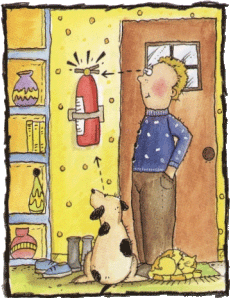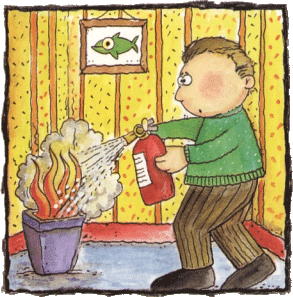Portable Fire Extinguishers: Do I Need One?
 WHAT IS FIRE?
WHAT IS FIRE?
Fire is a combination of oxygen, fuel, heat and chemical reaction This is called the Fire Triangle. Remove any one side of the triangle and the fire will go out.
WHY DO I NEED A PORTABLE FIRE EXTINGUISHER?
It is always better to fight a fire through prevention and early detection. However, with training and practice adults can use portable fire extinguishers to extinguish small, contained fires. Extinguishing a small-contained fire, such as a cooking pan, wastebasket fire or campfire may prevent needless injury and minimize property damage.
WHAT ARE THE DIFFERENT TYPES OF PORTABLE FIRE EXTINGUISHERS?
Portable fire extinguishers are categorized by ratings. These ratings determine the size and type of fire that the extinguisher can effectively put out. The three most common classes of fire are A, B, and C. The fourth class is D.
Check the extinguisher label and purchase an extinguisher that is appropriate for the type and size of fire you may encounter. Only choose extinguishers that have been tested by an approved testing laboratory and labelled for their intended use (e.g. UL, ULC).
| A | This symbol indicates an extinguisher that may be used on ordinary combustibles including wood, paper, plastic or cloth. This symbol may be found on water, foam or multipurpose extinguishers. |  |
| B | This symbol indicates an extinguisher that is appropriate for use on flammable or combustible liquids. This symbol may be found on multipurpose dry chemical, dry chemical, and carbon dioxide extinguishers. |  |
| C | This symbol indicates an extinguisher that may be used on fires involving energized electrical equipment. This symbol may be found on carbon dioxide, multi-purpose dry chemical, and dry chemical extinguishers. |  |
| D | This symbol indicates an extinguisher that may be used on some types of combustible metals including magnesium, sodium, and potassium. This symbol may be found on dry chemical extinguishers. You will rarely encounter a "D" class fire in the home or office. |  |
WHERE SHOULD I INSTALL MY PORTABLE FIRE EXTINGUISHER?
- Extinguishers should be located in convenient locations throughout the home.
- Place them in areas that contain potential fire hazards such as the kitchen (not too close to the stove), workshop, garage, and basement.
- In each area, place the extinguisher near the door so you can reach it easily, extinguish the fire and ensure a quick, safe escape.
 |
| Install extinguishers in plain view. |
 HOW DO I USE A PORTABLE FIRE EXTINGUISHER PROPERLY?
HOW DO I USE A PORTABLE FIRE EXTINGUISHER PROPERLY?
Always follow manufacturer's instructions for the size and type of extinguisher you are using.
- Keep well back of the fire when using the extinguisher.
- Hold the extinguisher with the nozzle pointing away from you. Remove the pin or lever release mechanism, unlocking the operating lever.
- Aim the extinguisher nozzle at the base of the fire. Hold the extinguisher vertically.
- Squeeze the handle fully to release the contents of the extinguisher.
- Move the nozzle from side to side in a sweeping motion at the base of the fire. Fight the fire closest to you and continue the sweeping motion until the fire is extinguished.
NOTE: If your extinguisher is empty or the fire grows larger, leave the building immediately, closing the doors behind you. Once outside, call 9-1-1 or your local emergency number. Do not re-enter the building until the fire department says it is "SAFE" to do so.
IF I DISCOVER A FIRE, SHOULD I USE A PORTABLE FIRE EXTINGUISHER
 |
| For use on small contained fires. |
Yes, ONLY if the following conditions apply:
- Everyone has left the fire area, and is evacuating the building.
- The fire department has been called.
- The fire is confined to a small area.
- A clear escape route exists between you and the fire.
- There is an appropriate, working fire extinguisher available.
- You have read the extinguisher instructions and have received training in its safe operation.
IS THERE ANYTHING ELSE I NEED TO KNOW?
- Follow manufacturer's instructions for care and maintenance.
- Check the extinguisher pressure gauge every month to ensure the unit is holding its charge.
- Regardless of the amount of extinguishing agent used, assume the extinguisher is empty. Refill or replace the extinguisher after each use. Rechargeable models should be serviced after every use and remember that disposable extinguishers must be replaced.
| Sponsored By: | ||||
 |
 |
 |
 Insurance InsuranceBrokers Association |
 |
| Greater Vancouver Fire Chiefs Association Public Education Committee | ||||
